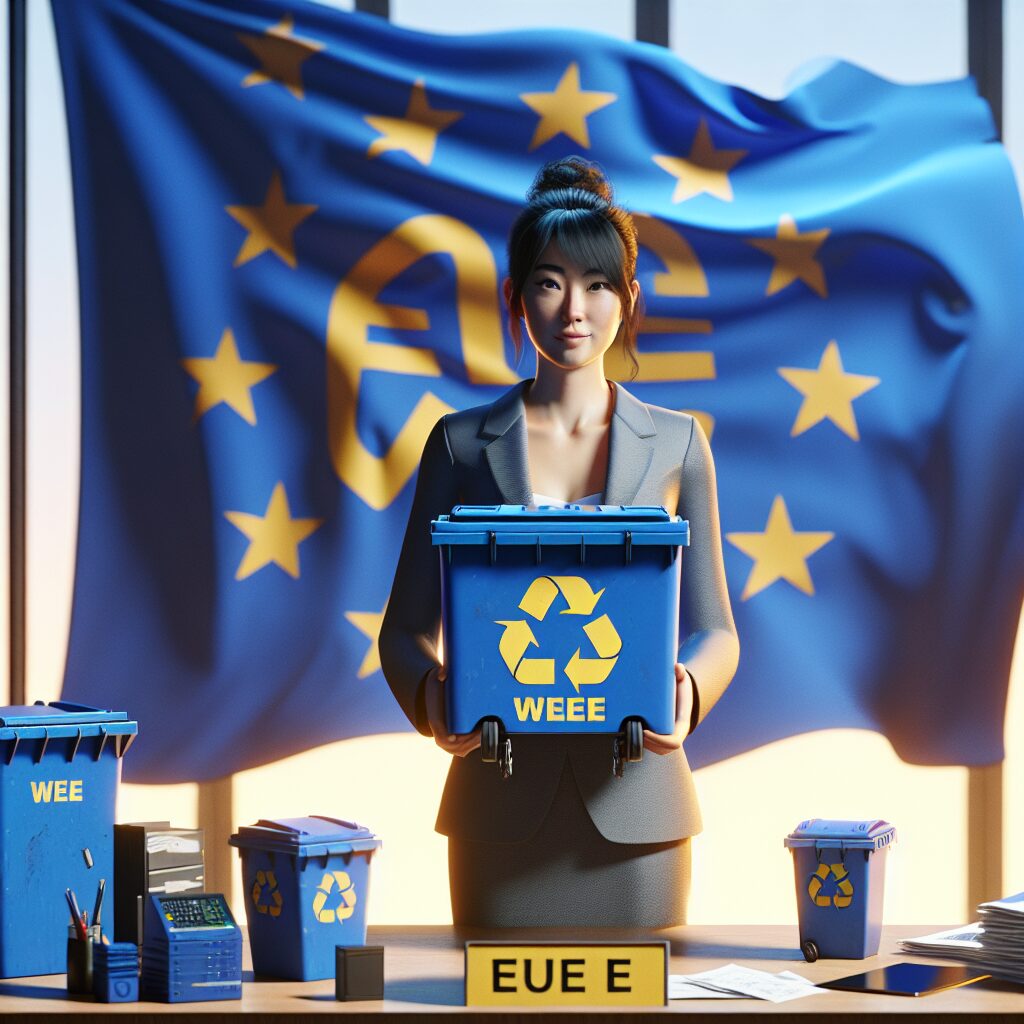About eldris
At Eldris, we automate SEO, multilingual site expansion, and EU compliance for brands scaling across Europe. Our AI-powered platform handles everything from content publishing to regulatory docs—so you don’t have to.
In This Article
- WEEE compliance is mandatory for all electronics producers targeting the EU market.
- Non-EU brands must appoint authorised representatives in each Member State.
- Registration requirements differ by country and must be managed separately.
- Joining a Producer Compliance Scheme simplifies reporting and financing obligations.
- Product labelling and data retention are critical for audit-readiness.
- Non-compliance can result in fines, sales bans, and reputational damage.
- Digital tools and partners can streamline multi-country compliance efforts.
- Turning WEEE compliance into a market advantage enhances sustainability reputation and access.
What Is WEEE Compliance and Why It Matters in the EU
Overview of WEEE Obligations for Electronics Producers
WEEE compliance refers to the fulfilment of responsibilities set forth by the European Union under the Waste Electrical and Electronic Equipment Directive. This legislation governs the collection, treatment, recycling, and environmentally sound disposal of electronic and electrical goods at the end of their life cycle. Originally enacted in 2003 and recast in 2012 (2012/19/EU), the WEEE Directive applies to all producers of electrical and electronic equipment (EEE) within the EU market. Whether based inside or outside the EU, brands selling directly or indirectly to EU consumers are required to adhere to these compliance measures.
Producers must follow a range of schemes to ensure that used electronics do not contribute to landfill waste or environmental degradation. This involves proper labelling, financing the collection and recycling processes, and regularly reporting volumes placed on the market. Given increasing environmental scrutiny and the European Green Deal’s objectives, WEEE compliance is now central to a company’s sustainability credentials and market access strategy.

Who Is Legally Responsible for WEEE Compliance?
Definition of ‘Producer’ Under EU Law
Under EU WEEE regulations, the term “producer” holds legal significance. A producer is any individual or organisation that manufactures and sells EEE under its own name within an EU country, imports EEE into an EU country, or sells EEE directly via distance selling to end users in an EU country. This definition includes both EU-based companies and non-EU companies engaging in cross-border trade into the EU.
The scope of responsibility includes both business-to-consumer (B2C) and business-to-business (B2B) streams. Notably, B2C equipment has additional obligations such as visible eco-contributions and public awareness campaigns. Companies failing to accurately identify their producer status may face financial penalties, product bans, or reputational harm.
“Your legal responsibility does not begin when electronics break—but the moment you place them on the EU market.”
WEEE Registration Requirements by EU Country
Each EU Member State implements the WEEE Directive via national legislation, resulting in slightly differing rules for registration across countries. Generally, producers must register with the applicable national WEEE authority or an approved compliance scheme within the country where they place EEE on the market. This registration must occur before the first product is sold within that jurisdiction.
For example, in Germany, obligations are managed under the ElektroG and registration must occur via the Stiftung EAR. In France, the Agence de la transition écologique (ADEME) oversees enforcement. Delays or omissions in registration may result in heavy administrative penalties or even prohibition of sales within the market. Producers must also obtain a unique registration number in each country, which needs to be displayed on invoices or accompanying documentation.
Crucially, non-EU producers must appoint an authorised representative in each Member State to carry out registration and reporting duties on their behalf. Navigating this multi-jurisdictional process can be demanding; thus, working with a qualified compliance partner may prove cost-effective and efficient. <a href="Learn more about EU Product Compliance & Extended Producer Responsibility“>Learn more about EU Product Compliance & Extended Producer Responsibility
Understanding EEE Labelling and Documentation Standards
One of the foundational aspects of WEEE compliance is proper labelling of products. Every compliant product must carry the crossed-out wheeled bin symbol to indicate that it should not be disposed of with general waste. This symbol, usually placed on the product casing or packaging, must be visible, legible, and indelible for the entire lifespan of the product.
In addition to this icon, products may also need a date of manufacture mark, along with details identifying the producer. Labels must align with the specific language and format standards of the country in which the product is distributed. Maintaining up-to-date documentation is crucial. Producers must store records of equipment placed on the market, including weight, type of product, and distribution channel.
These records serve a dual purpose: they help producers stay audit-ready and are necessary for national register submissions. The more granular and accurate your documentation, the easier it is to meet compliance targets and defend against enforcement actions.
Joining a Producer Compliance Scheme (PCS) in the EU
Most producers fulfil their obligations through participation in a Producer Compliance Scheme (PCS). These schemes, also known as collective compliance organisations, act on behalf of member producers to ensure proper collection, recycling, and reporting of end-of-life products. PCS providers handle everything from financing to logistics to data submissions, making them a practical solution for brands with limited internal compliance resources.
The majority of Member States mandate producer membership in one of these schemes. PCS operators are typically regulated and approved by competent national authorities. Upon joining, a company must declare its annual put-on-market volumes, pay eco-fees, and submit regular data logs through secure portals.
Failure to join a PCS is often interpreted as deliberate non-compliance. In addition, participation provides added credibility when marketing sustainability claims. Choosing a PCS that operates in multiple countries can also improve harmonisation for cross-border sellers. <a href="Official EU WEEE responsibilities and requirements“>Official EU WEEE responsibilities and requirements
WEEE Reporting Guidelines and Collection Targets
Every registered producer must file periodic reports detailing the quantities and categories of EEE placed on the market, as well as the WEEE collected and treated. The frequency of reporting varies by Member State, but quarterly and annual declarations are most common. Reports are submitted using standard templates supplied by national authorities or the PCS.
The WEEE Directive also establishes recovery and recycling targets. For instance, producers may be required to finance the collection of 65% of the average weight of EEE placed on the market over the previous three years. Certain categories like lighting equipment and IT devices have their own collection benchmarks.
Achieving these targets may require investment in take-back schemes, drop-off points, or consumer incentive programmes. Reporting accuracy is essential, and audits of producer data are not uncommon. Penalties for under-reporting can include fines or suspension of registration status.
Consequences of WEEE Non-Compliance for Brands
The risks of ignoring WEEE responsibilities are considerable. Regulatory bodies across the EU have full authority to impose administrative fines, ban non-compliant products from the market, or initiate criminal proceedings in severe cases.
In addition, platforms like Amazon, Zalando, and eBay increasingly require producers to provide valid WEEE registration numbers before allowing product listings in EU markets. A lack of compliance may therefore result in not only legal liability but also direct loss of sales channels. Public exposure of non-compliance can also irreparably damage brand reputation in environmentally conscious markets.
Proactively managing WEEE obligations is thus far more cost-effective than dealing with the aftermath of enforcement actions. <a href="Read a related article“>Read a related article
Best Tools and Services to Manage WEEE Compliance Efficiently
Given the complexity involved, many businesses opt for digital tools to streamline their WEEE compliance. Advanced compliance solutions now offer automated data collection, multi-country registration support, and real-time reporting dashboards. These platforms reduce manual errors, standardise data formats, and increase audit-readiness.
In conjunction with software, some consultancy firms also provide full-service WEEE management—from setting up authorised representatives to liaising with national enforcement bodies. Choosing the right mix of technology and service partners can significantly reduce the compliance burden while ensuring 100% legal conformity.
Key tools also help with life-cycle assessments (LCAs), helping brands improve not just compliance but also product eco-design. Vendors such as Compliance & Risks, Ecodesk, and ERP provide integrated WEEE solutions tailored to the needs of multinational enterprises. <a href="WEEE compliance tools for EU brands“>WEEE compliance tools for EU brands
Cross-Border WEEE Compliance for Multi-Market Sellers
Brands that sell in multiple EU Member States face additional complexity. Each jurisdiction requires its own WEEE registration, reporting process, and potentially different compliance schemes. A product legally sold in France must be separately registered in Spain if also offered there.
The concept of harmonised obligations is still evolving, and until unified EU-level systems emerge, companies must manage country-specific responsibilities in parallel. Many businesses find it beneficial to adopt simplified product labelling and tracking systems early in their expansion strategies.
In addition, coordinating scalable back-office functions—for logistics, finance, and legal teams—enables easier adaptation to regulatory changes down the line. Internal alignment is a critical enabler for sustainable compliance maturity.
Preparing for Audits and Long-Term WEEE Documentation
Audits form a critical part of any robust WEEE compliance programme. Auditing bodies, either national authorities or third parties acting on their behalf, may request historical records, product volume evidence, and demonstration of financial contributions to recycling efforts. Being caught off guard in such reviews can have material financial and legal consequences.
Accordingly, brands must implement document retention strategies aligned with national laws—typically five to ten years. This includes sales records by SKU, correspondence with compliance schemes, and evidence of registered representatives. Cloud storage with regionally secure backup and indexing functions is recommended.
Scheduled internal audits, preferably annually, are an industry best practice. These not only support continuous improvement but also ensure that less apparent risks, such as misaligned internal reporting filters, are identified and corrected.
Conclusion: Turn WEEE Obligations Into Market Advantage
[CONCLUSION_CONTENT]
WEEE compliance is no longer a box-ticking exercise. It’s a dynamic, multidimensional regulatory framework that touches every aspect of your operations—from product labelling to end-of-life recycling. When implemented correctly, WEEE obligations evolve into strategic assets. They demonstrate a brand’s responsibility, support sustainable consumer expectations, and open market access throughout the EU.
By understanding legal responsibilities, integrating technology, collaborating with established PCSs, and forecasting well for audits, businesses can stay ahead of market demands while reducing environmental impact. In short, WEEE compliance is not just a cost of doing business—it’s a gateway to better, greener business practices across borders.
Great guide on weee-responsibility-eu-brands-explained – Community Feedback
Who is responsible for WEEE compliance in the EU?
Producers of electrical and electronic equipment (EEE) are responsible for WEEE compliance in the EU, including registering, organising collection and recycling, and reporting to national authorities.
What steps must EU brands take to meet WEEE obligations?
Brands must register as a producer, correctly label EEE, join a producer compliance scheme, ensure proper take-back and recycling, and submit regular reports for WEEE placed on each EU market.
What are the risks for not complying with WEEE in the EU?
Non-compliance with WEEE can result in product delisting, fines, barriers to market access, and reputational damage. Ongoing legal obligations require up-to-date and auditable compliance.








